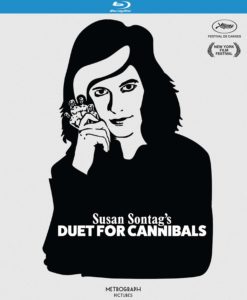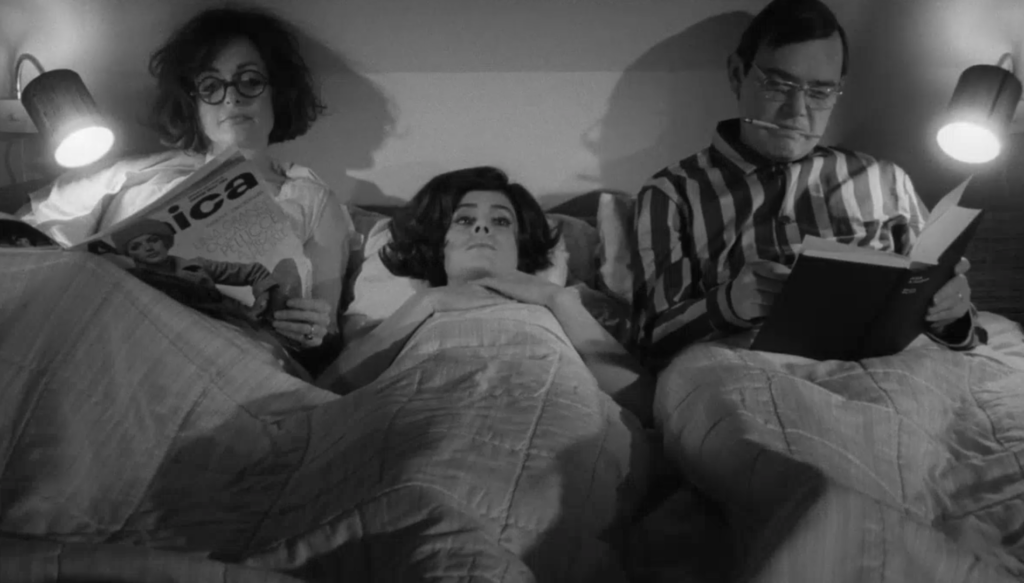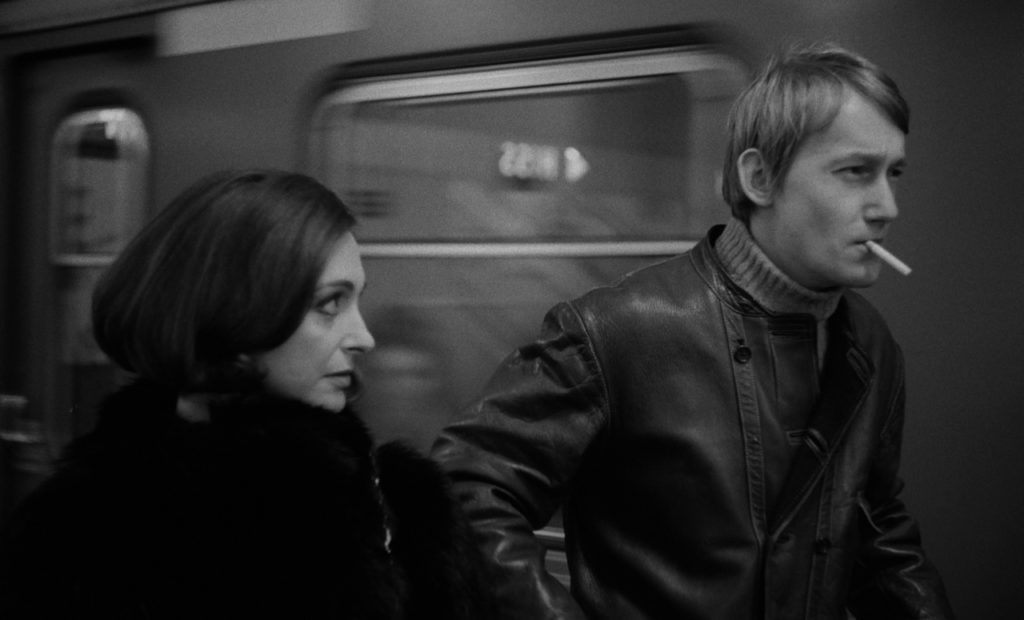It’s the 50th Anniversary of That Time Feminist Critic and Essayist Susan Sontag Went Behind the Camera… and to Sweden.
DIRECTED BY SUSAN SONTAG/SWEDISH/1969
BLU-RAY STREET DATE: MAY 26, 2020/METROGRAPH

“What’s an outspoken intellectual like you doing in a chronically neutral place like this?” That is a very valid question for noted American writer and thinker Susan Sontag. The place was Sweden. The year was 1969. The reason? She was making a movie.
Of all the accomplishments on the late Ms. Sontag’s impressive list, “film directing” tends to not even make the cut. She only made a sparse handful of films, alternating between other pursuits and causes in her restless and busy pre-cancerous life. She is, of course, primarily known as an essayist, as the written word would always be her medium of choice. Within that sphere though, she would often gestate, quite contentedly, in the rippling waters of film analysis. In a time when intellectual deep dives into the works of Bergman, Godard, and numerous other worldly iconoclasts with cameras was de rigueur, Sontag, in all her condescending eruditeness, was, in retrospect, right at home.
Therefore, Duet for Cannibals (Duett för kannibaler), her debut film effort, is both a logical offshoot and something of a bizarre tangent. Why was it made in Sweden, and in Swedish to boot? Apparently, the answer may be so simple as Sweden asked nicely and had money on the table. Per most works of legitimate Swedish cinema of the era, the budget was the dining equivalent of a quiet picnic by the side of the road as opposed to 1969 Hollywood’s unending buffet of deep-fried red meats and too many sides. (Sontag’s foray into filmmaking may be one of few notable cinematic events of that year that didn’t register in Tarantino’s Once Upon a Time …in Hollywood).
Duet for Cannibals is a veritable four-hander, if you will. It starts with a post-collegiate engaged couple, Tomas and Ingrid (Gösta Ekborg and Agneta Ekmanner), cohabitating in all their generic late-1960s political activism tropes. Next to a faux-military Vietnam poster, up goes the likeness of someone called Arthur Bauer (Lars Ekborg). Coincidentally, Tomas soon finds himself hired by that very fellow. A dream job? More like some sort of nightmare… of the waking variety.
Sontag, in a perhaps surprisingly formidable bit of directing, lends a latent surreality to the increasingly ensnaring narrative. Although Tomas is told that his job is to sort Bauer’s office-full of sensitive papers, letters, correspondences, and communiques, he’s soon also being told to keep an eye on and entertain his very oddly beguiling wife, Francesca (played by Italian actress Adrianna Asti, the only cast member Sontag desired in the writing process- and it shows). It becomes quickly apparent that Bauer considers Tomas not so much an employee as a live-in servant. “You must never leave!!”

As the film progresses, the situation deteriorates into an oneiric kind of housebound game of cat and mouse. Later, as Ingrid is reeled into the strangeness of the Bauer estate, Tomas finds himself on the outs. From there, the covert becomes overt, as the seduction do-si-do makes it quite clear that the spy game was really only ever about sex. James Bond, eat your hollow heart out.
As alluded to earlier, Duet for Cannibals proved to be a far more accomplished work than expected, particularly for a first film. Sontag as writer/director came at this unusual opportunity with no shortage of ambition and ideas, though she resists the urge to overstuff the movie itself. It moves steadily, and while unconventional, is far from unapproachable nor is it frozen in counter-culturally-flaunting 1960s amber (ala Tom White’s Who’s Crazy).
Cannibals, in its own way, has intrigue and mystery to spare. It’s also, at times, quite sexy. Like Ida Lupino before her, Sontag demonstrates that males alone do not have an exclusive claim on “the male gaze”. The only obvious thing that the film doesn’t have, amid its buffet of open consumption and revolving-door pairings, is literal cannibalism. The figurative is more than enough, thank you.
*****
Following a repertory theatrical release in honor of its fiftieth anniversary last year courtesy of Metrograph, Duet for Cannibals arrives to Blu-ray via Kino Lorber, and looking quite fine. The film is indeed in Swedish with English subtitles. The handful of bonus features run the gamut, the best being an unearthed half-hour television interview that groups Sontag and fellow cutting-edge feminist director Agnès Varda. Ostensibly, the subject is their bold new films, often compared and contrasted. (“Now Agnès, you are French but have made your film in Hollywood. But Susan is an American who chose to make her film In Sweden.”).
In actuality, one might read this long-form chat show (these days this sort of thing is relegated to podcasts) episode to be all about erudite airs and how fast the dark studio can fill up with cigarette smoke. There is certain pleasure in this visit to this era gone by, when unspoken tensions, much less the shouting and talking over one another of today, dare not shatter the veneer of proper, intelligent discourse. But really, the true scene-stealer is Sontag’s venomously fixated eye-darts. Even before the host can fully finish his first question to her, she already appears fed up. Chalk it up to a lifetime of being the smartest person in any given room but regularly dismissed for lack of a Y chromosome.

The other noteworthy disc extra (there is also a trailer for the film, and others) is a feature-length audio commentary by artist and writer Wayne Koestenbaum (Cleavage, Model Homes). Among Koestenbaum’s first pronouncements in his overly deliberate yet terminally fawning track is his regard for Sontag as his hero. He’s not kidding. Anyone hoping for a historically balanced venture into the broader career, importance and vitality of Susan Sontag will be disappointed by this drooling, deliberate admiration. Though full disclosure, as insufferable as the track is, I bailed after twenty-five minutes.
Additionally, there is a booklet with photos and an essay by film critic Adam Nayman. This essay, previously published by Metrograph, is entitled “Sontag, Scorsese, and the Cinema Itself: Duet for Cannibals”. This inclusion somewhat remedies the lack of needed analysis elsewhere in this release, though as its title implies, Nayman sees fit to work Martin Scorsese into the mix, particularly his infamous criticism of Marvel films. While this already-dated platform gives the essayist a topical jumping-off point to which he can then compare Sontag’s own divisive approach to film and film criticism, it also aids in hamstringing the focus on the film at hand. There’s a seeming assumption that the reader is already well-plugged into the life and times of Susan Sontag, which in the case of this curious critic, is not accurate. What Nayman and the rest of these extras do encourage is a deeper dive into the myriad of external material on this culturally significant figure and her myriad of work and opinions. Not even Sweden was far-reaching enough for her intellect and brand. And stating that is to in no way tune out Duet for Cannibals.

